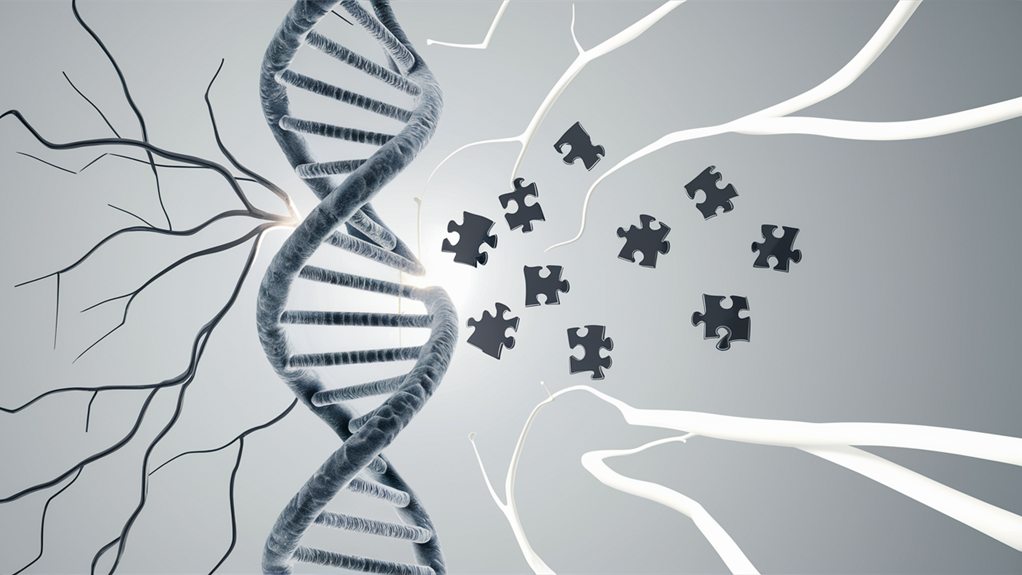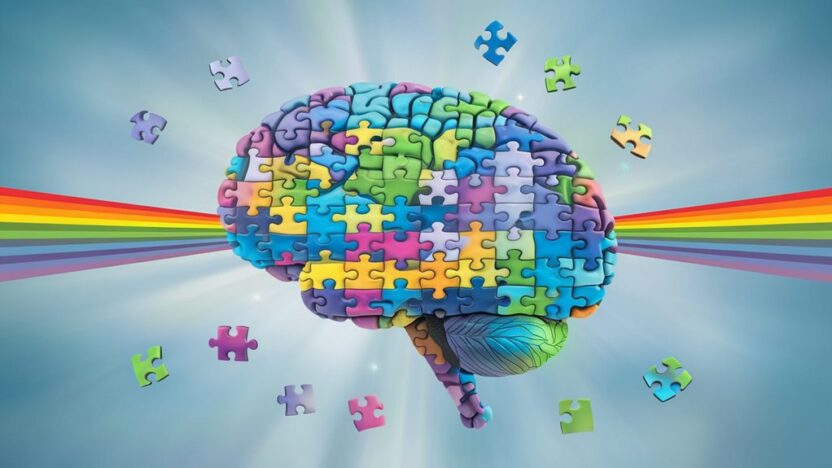Autism Spectrum Disorder (ASD) is a complex developmental condition that affects how you communicate, interact with others, and process the world around you. You'll notice signs typically before age three, including differences in social interactions, communication patterns, and repetitive behaviors. While there's no single cause, genetics and environmental factors play important roles. Each person with ASD has unique strengths and challenges, with some showing exceptional abilities in areas like memory, math, or art. Treatment options include behavioral therapy, speech therapy, and specialized education programs, all tailored to individual needs. The journey to understanding ASD reveals fascinating insights about human development and neurodiversity.
Understanding ASD

Understanding autism begins with recognizing that ASD symptoms can range from mild to severe, affecting various aspects of daily life.
You'll notice that people with ASD might process sensory information differently, finding certain sounds, lights, or textures overwhelming or fascinating. They may also communicate in unique ways, sometimes preferring direct language over subtle hints or social cues that others take for granted.
As you learn more about ASD, you'll find that many individuals on the spectrum have exceptional abilities in areas like memory, mathematics, or art.
While some may need significant support in their daily activities, others might require minimal assistance. This wide range of experiences and abilities is what makes the autism spectrum so diverse and remarkable.
Signs and Symptoms
Common signs of autism spectrum disorder typically emerge during early childhood, often before age three. You'll notice that children with ASD mightn't respond when you call their name, make eye contact, or share their interests with others.
They may also show repetitive behaviors, like rocking back and forth or lining up toys in specific patterns.
When seeking an autism spectrum disorder diagnosis, you'll want to pay attention to your child's communication skills. They might struggle with back-and-forth conversations, have delayed speech, or use unusual language patterns.
Some children with ASD are sensitive to sounds, lights, or textures that don't bother others, while some mightn't react to loud noises at all.
Early autism treatment and support for autism are essential for better outcomes. You might notice your child prefers to play alone, has difficulty understanding others' feelings, or follows strict routines that can cause distress if changed.
Causes and Risk Factors

Through years of research, scientists have identified multiple factors that contribute to autism spectrum disorder, though no single cause has been pinpointed. Research shows that your genes play a significant role, and if you have a sibling with ASD, you're more likely to develop it yourself. Environmental factors during pregnancy, such as exposure to certain medications or infections, can also increase your risk.
Scientists have discovered that some children might develop ASD if they're born to older parents, especially fathers over 40. If you were born prematurely or had a very low birth weight, you'll have a higher chance of developing ASD.
There's also evidence that complications during pregnancy, including extreme stress or specific infections, can affect your baby's brain development.
It's important to know that vaccines don't cause autism – this myth has been thoroughly debunked by numerous scientific studies. Your child's risk might increase if there's a family history of immune disorders, neurological conditions, or genetic syndromes.
Diagnosis Process
Medical professionals employ three main steps to diagnose autism spectrum disorder: developmental screening, thorough evaluation, and team assessment.
During your child's regular checkups, their doctor will observe behavior patterns and ask you questions about your child's development, which helps identify potential signs early on.
If your doctor notices any concerns during screening, they'll recommend a detailed diagnostic evaluation. During this process, you'll work with specialists who'll assess:
- Your child's cognitive abilities through various age-appropriate tests
- Your child's language and communication skills in different settings
- Your child's behavior patterns and social interactions with others
- Your family's medical history and your child's developmental timeline
The final step involves a team of professionals, including psychologists, speech therapists, and occupational therapists, who'll work together to make a diagnosis.
They'll combine their observations and test results to create a complete picture of your child's development. You'll receive detailed feedback about your child's strengths and challenges, and if ASD is diagnosed, they'll help you understand the level of support your child needs and recommend appropriate interventions.
Treatment Options

Treatment plans for autism spectrum disorder are highly individualized, as each person with ASD has unique needs and challenges. You'll often find that effective treatment involves a combination of different therapies and approaches, working together to support development and daily functioning.
Several proven treatments can help you or your loved one with ASD. Applied Behavior Analysis (ABA) therapy, which focuses on improving specific behaviors, is one of the most common and well-researched options. You might also benefit from speech therapy to enhance communication skills, or occupational therapy to develop daily living skills and motor coordination.
For some people with ASD, medications can help manage related conditions like anxiety, depression, or attention difficulties. You'll want to work closely with healthcare providers to find the right combination of treatments. Early intervention programs, which start in childhood, can make a significant difference in development and learning.
Don't forget about social skills training and cognitive behavioral therapy (CBT), which can help you navigate social situations and manage emotions.
Educational support, including specialized learning programs and classroom accommodations, is also an essential part of many treatment plans.
Support and Resources
Finding support and resources for autism spectrum disorder doesn't have to be overwhelming, thanks to numerous organizations and networks dedicated to helping individuals with ASD and their families.
You'll discover that both online and in-person resources can provide valuable assistance, education, and community connections.
When you're looking for support, you'll find several key resources available:
- National autism organizations, such as Autism Speaks and the Autism Society of America, which offer educational materials, support group directories, and advocacy programs
- Local support groups where you can connect with other families, share experiences, and learn practical strategies for daily challenges
- Educational resources through your school district's special education department, including individualized education programs (IEPs) and classroom accommodations
- Professional networks of autism specialists, including therapists, behavioral analysts, and occupational therapists who can guide your journey
You can also reach out to your healthcare provider, who'll help connect you with additional resources in your area.
Many communities offer specialized programs, recreational activities, and workshops designed specifically for individuals with ASD and their families, ensuring you're never alone in this journey.
Living With ASD

Living with autism spectrum disorder involves three key aspects: adapting daily routines, developing coping strategies, and building on personal strengths. You'll find that creating structured schedules, breaking tasks into smaller steps, and maintaining consistency can help you navigate daily life more effectively.
When you're dealing with sensory challenges, you'll want to develop personalized coping strategies that work for you. This might include using noise-canceling headphones in loud environments, finding quiet spaces when you're feeling overwhelmed, or using stim toys to help with focus and comfort.
Remember, it's perfectly okay to adapt your environment to meet your needs.
You can build on your unique abilities and interests to create opportunities for success. If you're particularly skilled at remembering details or have a strong interest in specific topics, you'll find these strengths can be valuable assets in school, work, and personal relationships.
Don't hesitate to communicate your needs to others, whether it's asking for additional time to process information or requesting written instructions instead of verbal ones. Your experiences are valid, and self-advocacy is an important part of living with ASD.
Research and Breakthroughs
Over the past decade, scientists have made significant advances in understanding the genetic and neurological basis of autism spectrum disorder. You'll be amazed to learn that researchers have identified hundreds of genes that may contribute to ASD, and they're using advanced brain imaging to see how these differences affect brain development and function.
Some of the most exciting breakthroughs in ASD research include:
- The discovery of specific brain circuits that work differently in people with autism, helping explain social and communication challenges
- Development of early screening tools that can identify signs of ASD in infants as young as 6 months old
- Advances in understanding how environmental factors interact with genetic predispositions
- New therapeutic approaches that combine behavioral interventions with targeted treatments
You'll find that researchers are also making progress in understanding how autism affects different people in unique ways. They're working on personalized treatment approaches that consider each person's specific challenges and strengths.
With continued funding and research, you can expect to see even more breakthroughs in understanding and treating ASD in the coming years.



